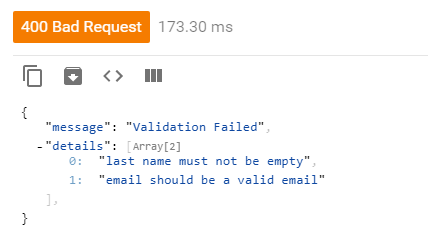
- Spring boot validation annotations how to#
- Spring boot validation annotations install#
- Spring boot validation annotations upgrade#
- Spring boot validation annotations registration#
- Spring boot validation annotations code#
The JwtTokenUtil is responsible for performing JWT operations like creation and validation.It makes use of the io.jsonwebtoken.Jwts for achieving this. We are only able to verify this hash if you have the secret key. To use this, we do not require to implement or configure any complex logic we can just start using the validation just by adding valid annotation with the. The secret key is combined with the header and the payload to create a unique hash.

What You Need About 15 minutes A favorite text editor or IDE Java 1.

Spring boot validation annotations how to#
You will also see how to display the error message on the screen so that the user can re-enter input to make it be valid. We specify the secret key using which we will be using for hashing algorithm. You will build a simple Spring MVC application that takes user input and checks the input by using standard validation annotations. The sequence flow for these operations will be as follows-Īdd the Spring Security and JWT dependenciesĭefine the application.properties. Import class HelloWorldController "/hello" })Ĭreate the bootstrap class with SpringBoot Annotation If you want to build more with Twilio and Java check out our quickstarts and the Java content on our blog.Create a Controller class for exposing a GET REST API. To learn more about that check out the Verify API and learn more about how Twilio can help with security by checking out Authy. So mark your controller class as Validated, which would trigger the validation of the id path variable.
Spring boot validation annotations code#
Of course this code does not check that the phone number actually belongs to the person filling out the form. The Validated annotation is a class-level annotation that we can use to tell Spring to validate parameters that are passed into a method of the annotated class. No small task - pat yourself on the back. Now you should only be able to proceed by entering a valid phone number, remembering the international dialling code if you aren’t in the USA.īy following along with this post you have built a Spring Boot application with custom validation using the Bean Validation Framework that calls the Twilio Lookup API to verify that a phone number is real. Stop the server that you ran before and restart it using. It’s time to restart your application and test it again. This also shows how you can override the default validation failure message. Annotations are declared with the keyword. In the same package as the other classes, create a new file called ValidPhoneNumber.java to hold the code for the annotation. Then you can use that annotation in the Person class.

These annotations are part of the Bean Validation framework that Spring uses when creating a Person object from the fields in the form. Start out by cloning the demo repository from github at the no-validation tag:

We will have a look at how we can add custom validations.
Spring boot validation annotations install#
My preferred way to install Java is with SDKMAN! Spring Custom Validations Spring makes our lives easier by providing us with built-in validations, but sometimes these are not enough.
Spring boot validation annotations upgrade#
Sign up using this link and you can get an extra $10 credit when you upgrade your account. The demo application will use Spring Boot and I will show how to use the Bean Validation framework to create a annotation that can be used like you would Starting out There are multiple levels of validation possible - in this post I’ll show how to use the Twilio Lookup API to check if a real phone number is real. To check that the number provided by your user is valid, you might reach for a regular expression, but that won’t be reliable - phone numbers are complicated, and it won’t tell you if the number provided is actually reachable.
Spring boot validation annotations registration#
Many user registration flows these days require a user to provide a phone number, either for two-factor authentication or to provide notifications and updates.


 0 kommentar(er)
0 kommentar(er)
